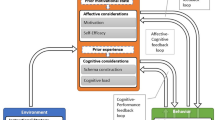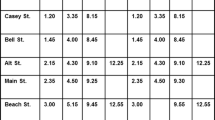Abstract
The concept of productive failure posits that a problem-solving phase prior to explicit instruction is more effective than explicit instruction followed by problem-solving. This prediction was tested with Year 5 primary school students learning about light energy efficiency. Two, fully randomised, controlled experiments were conducted. In the first experiment (N = 64), explicit instruction followed by problem-solving was found to be superior to the reverse order for performance on problems similar to those used during instruction, with no difference on transfer problems. In the second experiment, where element interactivity was increased (N = 71), explicit instruction followed by problem-solving was found to be superior to the reverse order for performance on both similar and transfer problems. The contradictory predictions and results of a productive failure approach and cognitive load theory are discussed using the concept of element interactivity. Specifically, for learning where element interactivity is high, explicit instruction should precede problem-solving.





Similar content being viewed by others
References
Chen, O., Kalyuga, S., & Sweller, J. (2015). The worked example effect, the generation effect, and element interactivity. Journal of Educational Psychology, 107(3), 689–704.
Chen, O., Kalyuga, S., & Sweller, J. (2016a). Relations between the worked example and generation effects on immediate and delayed tests. Learning and Instruction, 45, 20–30.
Chen, O., Kalyuga, S., & Sweller, J. (2016b). When instructional guidance is needed. Educational and Developmental Psychologist, 33(2), 149–162.
Chen, O., Kalyuga, S., & Sweller, J. (2017). The expertise reversal effect is a variant of the more general element interactivity effect. Educational Psychology Review, 29(2), 393–405. https://doi.org/10.1007/s10648-016-9359-1.
Chen, O., Castro-Alonso, J. C., Paas, F., & Sweller, J. (2018). Extending cognitive load theory to incorporate working memory resource depletion: evidence from the spacing effect. Educational Psychology Review, 30(2), 483–501. https://doi.org/10.1007/s10648-017-9426-2.
Cook, M. A. (2017). A comparison of the effectiveness of worked examples and productive failure in learning procedural and conceptual knowledge related to statistics (Order No. 10666475). Available from ProQuest Dissertations & Theses Global. (1984948629).
Cowan, N. (2001). The magical number 4 in short-term memory: A reconsideration of mental storage capacity. Behavioral and Brain Sciences, 24(1), 87–114.
Crooks, N. M., & Alibali, M. W. (2014). Defining and measuring conceptual knowledge in mathematics. Developmental Review, 34(4), 344–377.
DeCaro, M. S., & Rittle-Johnson, B. (2012). Exploring mathematics problems prepares children to learn from instruction. Journal of Experimental Child Psychology, 113(4), 552–568.
Fyfe, E. R., DeCaro, M. S., & Rittle-Johnson, B. (2014). An alternative time for telling: when conceptual instruction prior to problem solving improves mathematical knowledge. British Journal of Educational Psychology, 84(3), 502–519.
Geary, D. (2008). An evolutionarily informed education science. Educational Psychologist, 43(4), 179–195.
Geary, D., & Berch, D. (2016). Evolution and children’s cognitive and academic development. In D. Geary & D. Berch (Eds.), Evolutionary perspectives on child development and education (pp. 217–249). Switzerland: Springer.
Glogger-Frey, I., Fleischer, C., Grüny, L., Kappich, J., & Renkl, A. (2015). Inventing a solution and studying a worked solution prepare differently for learning from direct instruction. Learning and Instruction, 39, 72–87.
Glogger-Frey, I., Gaus, K., & Renkl, A. (2017). Learning from direct instruction: best prepared by several self-regulated or guided invention activities? Learning and Instruction, 51, 26–35.
Hirshman, E., & Bjork, R. A. (1988). The generation effect: support for a two-factor theory. Journal of Experimental Psychology: Learning, Memory, and Cognition, 14(3), 484.
Ho, J., Tumkaya, T., Aryal, S., Choi, H., & Claridge-Chang, A. (2018). Moving beyond P values: everyday data analysis with estimation plots. bioRxiv, 377978.
Hsu, C.-Y., Kalyuga, S., & Sweller, J. (2015). When should guidance be presented in physics instruction? Archives of Scientific Psychology, 3(1), 37–53.
Hwang, J., Choi, K. M., Bae, Y., Dong, & Shin, H. (2018). Do teachers’ instructional practices moderate equity in mathematical and scientific literacy? An investigation of the PISA 2012 and 2015. International Journal of Science and Mathematics Education. Advance online publication. https://doi.org/10.1007/s10763-018-9909-8.
Jacobson, M. J., Markauskaite, L., Portolese, A., Kapur, M., Lai, P. K., & Roberts, G. (2017). Designs for learning about climate change as a complex system. Learning and Instruction, 52, 1–14.
Kalyuga, S., Chandler, P., Tuovinen, J., & Sweller, J. (2001). When problem solving is superior to studying worked examples. Journal of Educational Psychology, 93(3), 579–588.
Kapur, M. (2012). Productive failure in learning the concept of variance. Instructional Science, 40(4), 651–672.
Kapur, M. (2014). Productive failure in learning math. Cognitive Science, 38(5), 1008–1022.
Kapur, M. (2016). Examining productive failure, productive success, unproductive failure, and unproductive success in learning. Educational Psychologist, 51(2), 289–299.
Kapur, M., & Bielaczyc, K. (2012). Designing for productive failure. Journal of the Learning Sciences, 21(1), 45–83. https://doi.org/10.1080/10508406.2011.591717.
Kirschner, P. A., Sweller, J., & Clark, R. E. (2006). Why minimal guidance during instruction does not work: an analysis of the failure of constructivist, discovery, problem-based, experiential, and inquiry-based teaching. Educational Psychologist, 41(2), 75–86.
Lai, P. K., Portolese, A., & Jacobson, M. J. (2017). Does sequence matter? Productive failure and designing online authentic learning for process engineering. British Journal of Educational Technology, 48(6), 1217–1227.
Leppink, J., Paas, F., Van Gog, T., Van der Vleuten, C., & Van Merrienboer, J. (2014). Effects of pairs of problems and examples on task performance and different types of cognitive load. Learning and Instruction, 30, 32–42.
Loibl, K., & Rummel, N. (2014a). The impact of guidance during problem-solving prior to instruction on students’ inventions and learning outcomes. Instructional Science, 42(3), 305–326.
Loibl, K., & Rummel, N. (2014b). Knowing what you don’t know makes failure productive. Learning and Instruction, 34, 74–85.
Martin, A. J. (2016). Using load reduction instruction (LRI) to boost motivation and engagement. Leicester: British Psychological Society.
Mayer, R. E. (2004). Should there be a three-strikes rule against pure discovery learning? American Psychologist, 59(1), 14–19.
Reber, A. S. (1989). Implicit learning and tacit knowledge. Journal of Experimental Psychology: General, 118(3), 219–235.
Rittle-Johnson, B., Fyfe, E. R., & Loehr, A. M. (2016). Improving conceptual and procedural knowledge: the impact of instructional content within a mathematics lesson. British Journal of Educational Psychology, 86(4), 576–591.
Rosenshine, B. (2009). The empirical support for direct instruction. In S. Tobias and T. Duffy (Eds.) Constructivist instruction: success or failure? (pp. 201–220). New York: Routledge. https://doi.org/10.1037/0003-066X.59.1.14, 59, 1.
Schwartz, D. L., & Bransford, J. D. (1998). A time for telling. Cognition and Instruction, 16(4), 475–522.
Schwartz, D. L., & Martin, T. (2004). Inventing to prepare for future learning: the hidden efficiency of encouraging original student production in statistics instruction. Cognition and Instruction, 22(2), 129–184.
Schwartz, D. L., Lindgren, R., & Lewis, S. (2009). Constructivism in an age of non-constructivist assessments. In Constructivist Instruction (pp. 46-73). Routledge.
Schwartz, D. L., Chase, C. C., Oppezzo, M. A., & Chin, D. B. (2011). Practicing versus inventing with contrasting cases: the effects of telling first on learning and transfer. Journal of Educational Psychology, 103(4), 759–775.
Schwonke, R., Renkl, A., Krieg, C., Wittwer, J., Aleven, V., & Salden, R. (2009). The worked-example effect: not an artefact of lousy control conditions. Computers in Human Behavior, 25(2), 258–266.
Slamecka, N. J., & Graf, P. (1978). The generation effect: delineation of a phenomenon. Journal of Experimental Psychology: Human Learning and Memory, 4(6), 592.
Sweller, J. (2010). Element interactivity and intrinsic, extraneous and germane cognitive load. Educational Psychology Review, 22(2), 123–138.
Sweller, J., & Chandler, P. (1994). Why some material is difficult to learn. Cognition and Instruction, 12(3), 185–233.
Sweller, J., & Paas, F. (2017). Should self-regulated learning be integrated with cognitive load theory? A commentary. Learning and Instruction, 51, 85–89.
Sweller, J., & Sweller, S. (2006). Natural information processing systems. Evolutionary Psychology, 4, 434–458.
Sweller, J., Ayres, P., & Kalyuga, S. (2011). Cognitive load theory. New York: Springer.
Sweller, J., van Merriënboer, J., & Paas, F. (2019). Cognitive architecture and instructional design: 20 years later. Educational Psychology Review, 31(2), 261–292.
Van Gog, T., Kester, L., & Paas, F. (2011). Effects of worked examples, example-problem, and problem-example pairs on novices’ learning. Contemporary Educational Psychology, 36(3), 212–218. https://doi.org/10.1016/j.cedpsych.2010.10.004.
Weaver, J. P., Chastain, R. J., DeCaro, D. A., & DeCaro, M. S. (2018). Reverse the routine: problem solving before instruction improves conceptual knowledge in undergraduate physics. Contemporary Educational Psychology, 52, 36–47.
Acknowledgements
We would like to acknowledge the students, parents, staff, and leadership team of the Ballarat Clarendon College for their support with this research.
Author information
Authors and Affiliations
Corresponding author
Ethics declarations
Prior to the study, approval was obtained from the Human Research Ethics Advisory Panel of the lead author’s institution.
Additional information
Publisher’s Note
Springer Nature remains neutral with regard to jurisdictional claims in published maps and institutional affiliations.
Rights and permissions
About this article
Cite this article
Ashman, G., Kalyuga, S. & Sweller, J. Problem-solving or Explicit Instruction: Which Should Go First When Element Interactivity Is High?. Educ Psychol Rev 32, 229–247 (2020). https://doi.org/10.1007/s10648-019-09500-5
Published:
Issue Date:
DOI: https://doi.org/10.1007/s10648-019-09500-5




